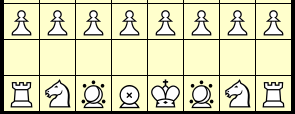[ List Earliest Comments Only For Pages | Games | Rated Pages | Rated Games | Subjects of Discussion ]
Single Comment
 H. G. Muller wrote on Fri, Oct 9, 2009 01:34 PM EDT:
H. G. Muller wrote on Fri, Oct 9, 2009 01:34 PM EDT:
Check out Makruk (Thai Chess), our featured variant for March, 2025.
 H. G. Muller wrote on Fri, Oct 9, 2009 01:34 PM EDT:
H. G. Muller wrote on Fri, Oct 9, 2009 01:34 PM EDT: